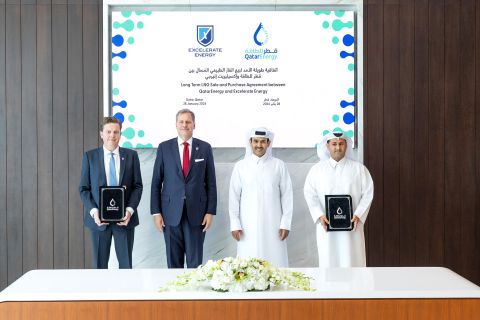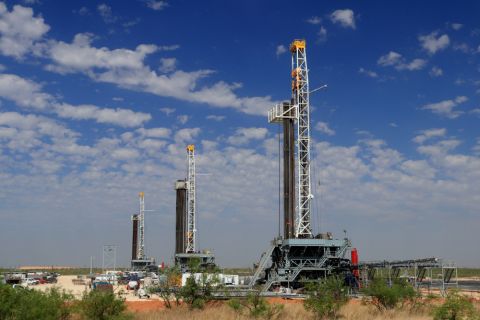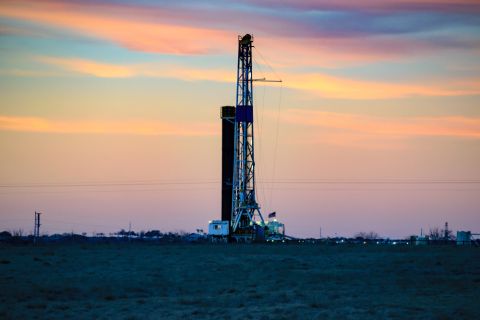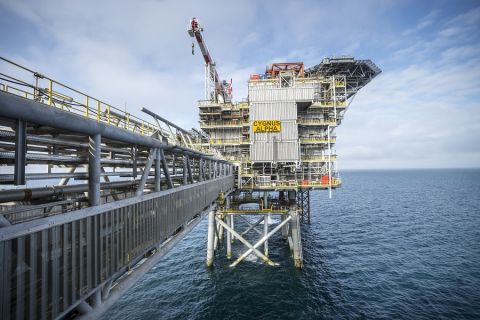Recent shifts in the economics of oil and gas production have driven operators to focus more attention on enhanced production techniques. What operators strive for is not only improved production within a well but also predictability of the refracture effectiveness across all their assets.
Fluid versus solid diverters
Fluid diversions, which use degradable or other agents to stimulate and/or plug existing fractures, have been shown to be effective in refracture operations. But production results can sometimes be inconsistent. Some in the industry refer to such methods as “pump and pray.” Alternatively, mechanical zonal isolation methods, such as a packer or complete installation of a new liner, offer the operator more control of the placement of the isolation. When a new liner is installed, the previous perforations are isolated, which provides more control to precisely place, perforate and fracture new stages. Having the ability to plan and place new fractures can provide more confidence in the refracture operation than pump-and-pray methods.
The advantage of the expandable liner is that the increased inside diameter (ID) reduces pressure loss, which, in turn, allows higher flow rates when fracturing. For example, when a 3.5-in. liner (2.750-in. ID) is installed and cemented within a 5.5-in. production liner, flow rates can be limited to 40 bbl/min to 70 bbl/min. A 4.25-in. expandable liner will have a post expanded ID of 4 in., which can achieve 70 bbl/min to 80 bbl/min with treatment pressure exceeding 10,000 psi. Installation of the expandable liner provides additional value by not requiring a cementing operation.
The number of these installations completed by Enventure tripled between 2014 and 2016. During this time, expandable liners shifted from vertical refractures to more horizontal refractures, and the total length continued to grow, with some exceeding 1,524 m (5,000 ft).
Understanding tensile forces
During an expandable refracture liner installation, the tensile forces within the liner need to be well understood. Four components contributing to the total tensile force:
- Residual force from expansion after cladding into the base casing;
- Force due to ballooning when fracture pressure is applied;
- Force resulting from thermal contraction that occurs when the liner is cooled from bottomhole temperature to near-surface temperature by circulating fracture fluid; and
- Force from the piston effect as pressure acts on each fracture plug to stretch the liner. Figure 1 shows the contribution of each of these forces.

With high reservoir temperatures 148.8-plus C (300-plus F) or high treatment pressures (10,000 psi), the sum of these forces can exceed the limitations of an expandable connection and cause a leak or a separation. To broaden the operating window for expandable liners used in mechanical isolations, improvements were needed to strengthen the connection for these environments.
New expandable connections
Enventure initiated a development effort that resulted in two new types of expandable connections. Conventional expandable thread designs are typically flush or semi-flush connections that can handle tension ratings ranging from 50% to 60% of the pipe body ratings and seldom greater than 75% of the pipe body ratings. Enventure enhanced its existing connection by 16% by increasing the critical cross section within the thread design. This increased rating allows installations with bottomhole temperatures in the 107.2 C to 121.1 C (225 F to 250 F) range (depending on ambient temperatures). A second high-temperature connection provides 39% higher tensile rating. This was achieved by combining a new expandable thread design on a thicker, or upset, pipe body end. This tensile rating allows installations with bottomhole temperatures in the 148.8-plus C range. Extensive finite element analysis was conducted on the new thread designs to simulate the expansion process, resulting in a modified expandable cone profile that ensures optimal expansion of the thread form as well as improving post-expansion seal reliability.
Testing and validation
Both connection designs were validated by conducting post-expanded internal pressure to failure, tension to failure and many combined pressure and tension loads to simulate various downhole conditions. During testing the API tensile yield rating improved enhanced connection from 190 kips to 225 kips and high-temperature connection to 265 kips. Combined loading conditions for a standard connection held up to 10,000 psi and 173 kips while the enhanced connection held to 14,500 psi and 260 kips; the high-temperature connection held at 17,000 psi and 356 kips.
During cyclic loading, to simulate cyclic loading while fracturing, the enhanced connection was tested for 120 cycles and showed no leak or pressure loss. The tests were performed under combined pressure and tension to
- 90% of connection ultimate failure loads (236 kips and 12,860 psi), 40 cycles;
- 95% (250 kips and 13,575 psi), 40 cycles; and
- 100% (263 kips and 14,290 psi), 40 cycles.
The sample was then taken to failure (greater than 290 kips and greater than 16,000 psi) where failure occurred at 110% of connection ultimate loads. All of the above calculations were based on 110-ksi yield and 125-ksi ultimate.
Planning mitigates risk
When planning an installation, a sensitivity analysis is performed using the operator’s specific fracture design and parameters. Maximum and minimum values of bottomhole and ambient temperature, fracture fluid density, treatment pressure and estimated reservoir pressure are all considered. The result of this analysis is a distribution of the stress state in the liner at each plug location. This distribution is compared to the safe operating envelope of each connection type to select the appropriate system to be used. This is conceptually shown in Figure 2.
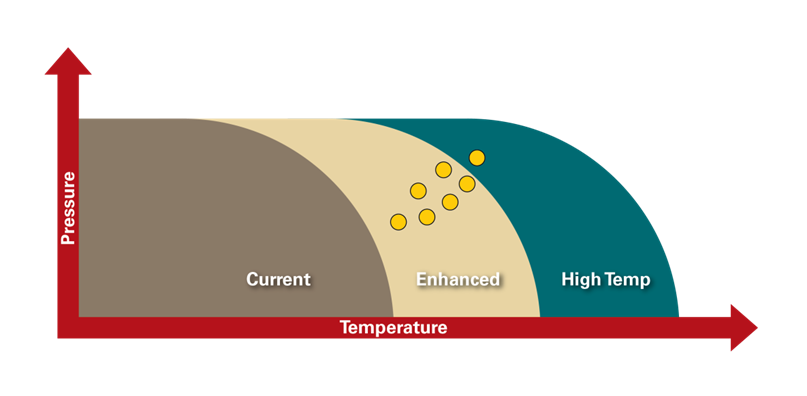
The operating envelope for each connection is shown relative to treatment pressure and bottomhole temperature. The dots represent the distribution of stress states in the liner for a sample analysis done for a Permian Basin well. The range of fracture parameters for this example falls within the specifications of the enhanced connection. However, one point falls into the high-temperature connection specifications. This result would then prompt selection of the high-temperature connection or to avoid the conditions resulting in that scenario, in this case not exceeding 10,000 psi.
Installations
The first field installation of the enhanced expandable liner occurred in South Texas where 1,524 m (5,000 ft) of a 4¼-in. liner was installed and expanded inside a 5½-in. liner with a bottomhole temperature of 110 C (230 F). A second 137.1-m (450-ft) installation occurred in West Texas, also inside 5½ in. at a bottomhole temperature of 73.8 C (165 F). Both installations were successfully installed, pressure tested and fractured with no indication of pressure loss. Production results are pending.
Expandable liner companies have completed numerous successful refracture installations in most basins in the U.S. During this growth it was learned that improvements were needed in expansion technology—along with preplanning collaboration with the operator—to perform installations in more extreme environments. In collaboration with the company’s clients, Enventure has extended the safe operating window with a tiered offering of expandable liners to provide zonal isolation ranging from vertical refratures to long horizontals and now into higher temperature environments.
Recommended Reading
Marketed: Anschutz Exploration Corp. WI Opportunity in Converse County, Wyoming
2024-01-26 - Anschutz Exploration Corp. retained EnergyNet for the sale of its WI participation option in Converse County, Wyoming.
Excelerate Energy, Qatar Sign 15-year LNG Agreement
2024-01-29 - Excelerate agreed to purchase up to 1 million tonnes per anumm of LNG in Bangladesh from QatarEnergy.
UK’s Union Jack Oil to Expand into the Permian
2024-01-29 - In addition to its three mineral royalty acquisitions in the Permian, Union Jack Oil is also looking to expand into Oklahoma via joint ventures with Reach Oil & Gas Inc.
Permian Resources Continues Buying Spree in New Mexico
2024-01-30 - Permian Resources acquired two properties in New Mexico for approximately $175 million.
Eni, Vår Energi Wrap Up Acquisition of Neptune Energy Assets
2024-01-31 - Neptune retains its German operations, Vår takes over the Norwegian portfolio and Eni scoops up the rest of the assets under the $4.9 billion deal.

